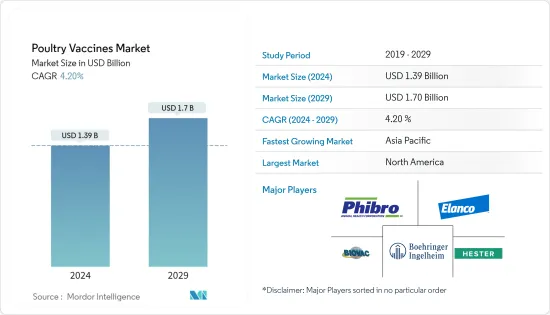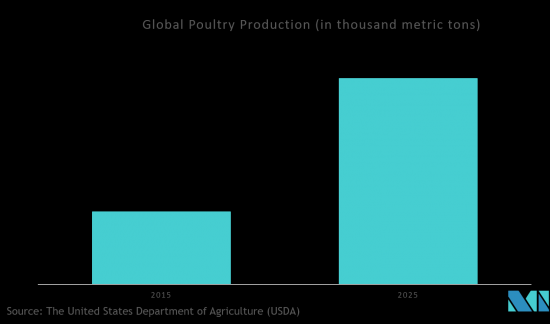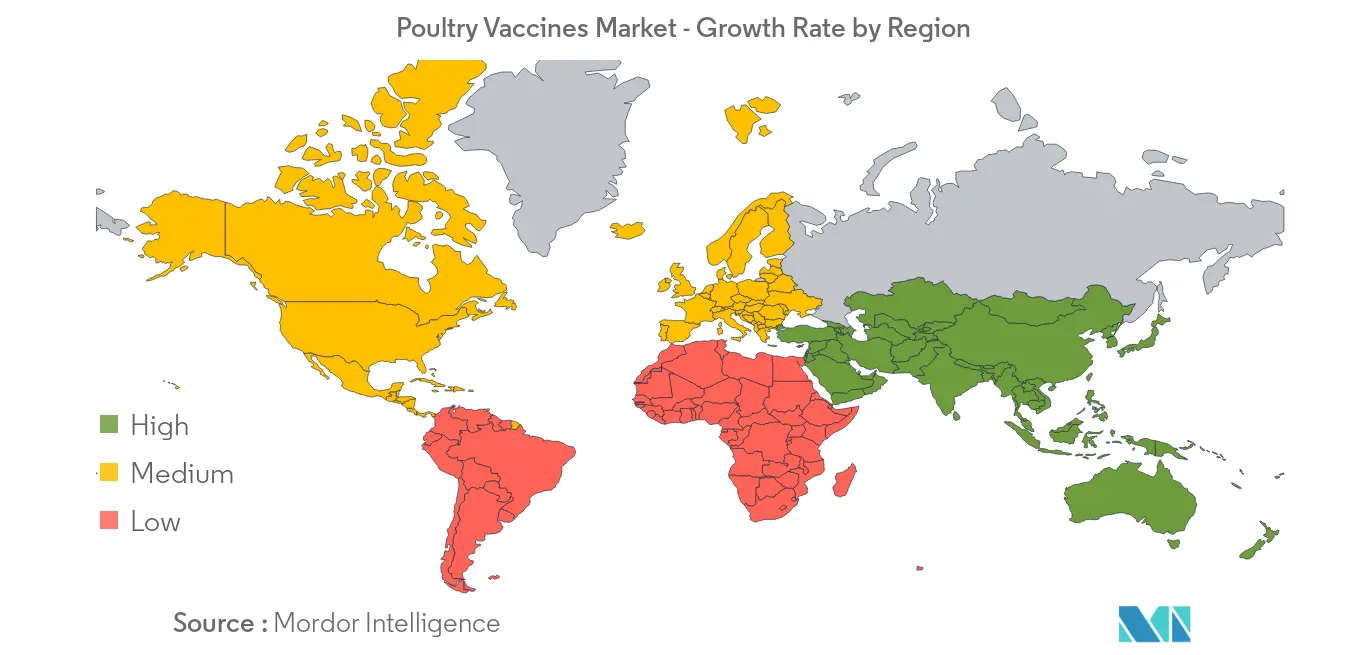
|
市場調査レポート
商品コード
1430004
家禽用ワクチン:市場シェア分析、産業動向&統計、成長予測(2024~2029年)Poultry Vaccines - Market Share Analysis, Industry Trends & Statistics, Growth Forecasts (2024 - 2029) |
||||||
カスタマイズ可能
適宜更新あり
|
|||||||
| 家禽用ワクチン:市場シェア分析、産業動向&統計、成長予測(2024~2029年) |
|
出版日: 2024年02月15日
発行: Mordor Intelligence
ページ情報: 英文 114 Pages
納期: 2~3営業日
|
- 全表示
- 概要
- 目次
家禽用ワクチン市場規模は2024年に13億9,000万米ドルと推定され、2029年には17億米ドルに達すると予測され、予測期間中(2024-2029年)にCAGR 4.20%で成長する見込みです。

この成長の主な要因は、家禽頭数の増加と家禽における人獣共通感染症の流行増加と相まって、家禽の健康に対する需要が高まっていることです。さらに、世界の食肉消費量の増加、政府による取り組み、家禽関連食品の需要増加、新しいワクチン製造のための最新技術、家禽医療費の増加が、世界の家禽用ワクチン市場の成長を促進している要因となっています。
家禽用ワクチン市場の動向
鳥インフルエンザが市場をリードする見込み
鳥インフルエンザは、世界中のあらゆる国で見られるウイルス性疾患で、鳥類に発生します。重症度は軽度から重度まで様々です。鳥インフルエンザは直接接触することでヒトに感染します。米国、アジア、欧州などの国々で病気の発生が報告されています。
ワクチンは、世界動物保健機構(WHO)が定めた基準をクリアしたものだけが承認されます。鳥インフルエンザ・ワクチンは、ヘマグルチニン(HA)タンパク質に対する防御を身につけるために接種されます。
世界保健機関(WHO)によると、2020年3月27日、台湾からOIEに鳥の間で高病原性鳥インフルエンザ(HPAI)A(H5N2)の新たな発生が2件報告されました。発生はYunlin countyの2つの郷で発生しました。確認された9,578羽の感受性のある鳥のうち、1,819羽が死亡し、残りの7,759羽は殺処分されました。
さらにCDCは、この病気の死亡率は約90%から100%であると報告しています。これはこの病気が高いリスクを伴うことを示しています。したがって、規制機関は現在、獣医衛生に関連する様々なワクチンの承認プロセスを加速させています。

予測期間中、北米が優位を占める見込み
予測期間中、北米の家禽用ワクチンは世界市場で大きなシェアを占めると予想されますが、これは家禽由来製品の消費量の増加、食の安全に関する消費者の意識の高まり、家禽に関連する人獣共通感染症の発生率の増加といった要因によるものです。
米国農務省(USDA)が公表したデータによると、2016年の鶏肉製品の1人当たり消費量は107.6ポンドであり、2017年には108.6ポンドに増加しました。さらに、国連食糧農業機関(UNFAO)が発表した統計によると、この地域では卵と鶏の生産量が増加しています。米国における動物用ワクチンは、動植物検疫局(APHIS)の動物用生物製剤センター(CVB)によって規制されています。CVBは、動物用生物製剤を製造・販売するために、動物用医薬品会社に設立と製品認可を与えています。
また北米では、ワクチン開発における進歩として、生ベクターワクチン、非複製組み換え抗原ワクチン、核酸媒介ワクチン、生遺伝子除去ワクチンの開発が挙げられます。これが予測期間中の市場成長を促進すると思われます。

家禽用ワクチン産業の概要
家禽用ワクチン市場のプレーヤーは、市場での存在感を高めるため、提携、パートナーシップ、契約、M&Aなど様々な成長戦略に取り組んでいます。主な参入企業は、Bio-Vet、Boehringer Ingelheim、Ceva Animal Health、Elanco、Merck &Co.、Phibro Animal Health Corporation、Venkys、Zoetis Inc.などです。
その他の特典:
- エクセル形式の市場予測(ME)シート
- 3ヶ月間のアナリストサポート
目次
第1章 イントロダクション
- 調査の成果
- 調査の前提
- 調査範囲
第2章 調査手法
第3章 エグゼクティブサマリー
第4章 市場力学
- 市場概要
- 市場促進要因
- 家禽類および人獣共通感染症の増加
- 食品安全への注目の高まり
- 市場抑制要因
- 偽造医薬品の使用
- 動物検査と獣医サービスのコスト増加
- ポーターのファイブフォース分析
- 新規参入業者の脅威
- 買い手/消費者の交渉力
- 供給企業の交渉力
- 代替品の脅威
- 競争企業間の敵対関係の強さ
第5章 市場セグメンテーション
- 疾患別
- 気管支炎
- 鳥インフルエンザ
- ニューカッスル病
- マレック病
- その他
- 技術別
- 組み換えワクチン
- 不活化ワクチン
- 生ワクチン(LAV)
- その他
- 地域別
- 北米
- 米国
- カナダ
- メキシコ
- 欧州
- ドイツ
- 英国
- フランス
- イタリア
- スペイン
- その他欧州
- アジア太平洋
- 中国
- 日本
- インド
- オーストラリア
- 韓国
- その他アジア太平洋地域
- 中東・アフリカ
- GCC
- 南アフリカ
- その他中東とアフリカ
- 南米
- ブラジル
- アルゼンチン
- その他南米
- 北米
第6章 競合情勢
- 企業プロファイル
- Biovac
- Boehringer Ingelheim International GmbH
- Ceva Sante Animale
- Dechra Pharmaceuticals PLC
- Elanco
- Hester Biosciences Limited
- Merck & Co., Inc.
- Phibro Animal Health Corporation
- Venky's Limited
- Zoetis Inc.
第7章 市場機会と今後の動向
The Poultry Vaccines Market size is estimated at USD 1.39 billion in 2024, and is expected to reach USD 1.7 billion by 2029, growing at a CAGR of 4.20% during the forecast period (2024-2029).

The growth is primarily attributed to rising demand for the poultry health coupled with the increasing poultry headcount and increasing prevalence of zoonotic diseases in poultry. Furthermore, the growing consumption of meat globally, initiatives are taken by the government, growing demand for poultry-related food products, latest technologies for manufacturing new vaccines and the increasing poultry healthcare expenditure are the factors that are fueling the growth of the global poultry vaccines market.
Poultry Vaccines Market Trends
Avian influenza is Expected to Lead the Market
Avian influenza is a viral disease which is found across all the countries in the world and occurs in birds. The severity of the disease can vary from mild to severe. Avian influenza is transmitted to human beings by direct contact. Disease outbreaks have been reported in countries, such as the United States, Asia, and Europe.
The vaccines are approved only if they pass the standards set by the World Organization for Animal Health. The vaccine for the avian influenza is given to imbibe the protection against hemagglutinin (HA) protein.
According to toWorld Health Organization, On 27 March 2020, two new outbreaks of highly pathogenic avian influenza (HPAI) A(H5N2) among birds were reported to OIE from Taiwan, China. The outbreaks occurred in two townships in Yunlin county. Among 9,578 susceptible birds identified, there were 1,819 deaths and the remaining 7,759 poultry were culled.
Furthermore, the CDC has reported that the mortality for this disease is around 90%-100%. This shows that the disease is associated with the high risk. Hence, the regulatory bodies are now accelerating the process of approval for various vaccines related to the veterinary health.

North America is expected to dominate over the Forecast Period
North America poultry vaccine is expected to have a significant share in the worldwide market over the forecast period, owing to the factors, such as the increase in consumption of poultry-derived products, growing consumer awareness regarding food safety, and increasing incidence of zoonotic diseases associated with poultry.
According to the data published by the US department of agriculture (USDA), the per capita consumption of poultry products in 2016 was 107.6 pounds and was increased to 108.6 pounds in 2017. Furthermore, there is an increase in the production of eggs and hen in the region, as per the statistics published by the UNFAO. Veterinary Vaccines in the United States is regulated by the Center for Veterinary Biologics (CVB) in the Animal and Plant Health Inspection Service (APHIS). The CVB grants establishment and product license to animal health companies, to manufacture and sell veterinary biologics.
Also, in North America advancements in vaccines development include the development of live vector vaccines, non-replicating recombinant antigen vaccines, nucleic acid-mediated vaccines, and live-gene-deleted vaccines. This is likely to fuel the market growth over forecast period.

Poultry Vaccines Industry Overview
The market players in the poultry vaccines market are involving in various growth strategies such as collaborations, partnerships, agreements, mergers and acquisitions in order to enhance the market presence. Few key players in the market are Bio-Vet, Boehringer Ingelheim, Ceva Animal Health, Elanco, Merck & Co., Phibro Animal Health Corporation, Venkys, and Zoetis Inc.
Additional Benefits:
- The market estimate (ME) sheet in Excel format
- 3 months of analyst support
TABLE OF CONTENTS
1 INTRODUCTION
- 1.1 Study Deliverables
- 1.2 Study Assumptions
- 1.3 Scope of the Study
2 RESEARCH METHODOLOGY
3 EXECUTIVE SUMMARY
4 MARKET DYNAMICS
- 4.1 Market Overview
- 4.2 Market Drivers
- 4.2.1 Increasing Incidences of Poultry and Zoonotic Diseases
- 4.2.2 Widened Focus on Food Safety
- 4.3 Market Restraints
- 4.3.1 Use of Counterfeit Medicine
- 4.3.2 Increasing Costs of Animal Testing and Veterinary Services
- 4.4 Porter's Five Force Analysis
- 4.4.1 Threat of New Entrants
- 4.4.2 Bargaining Power of Buyers/Consumers
- 4.4.3 Bargaining Power of Suppliers
- 4.4.4 Threat of Substitute Products
- 4.4.5 Intensity of Competitive Rivalry
5 MARKET SEGMENTATION
- 5.1 By Disease
- 5.1.1 Bronchitis
- 5.1.2 Avian Influenza
- 5.1.3 Newcastle disease
- 5.1.4 Marek's Disease
- 5.1.5 Others
- 5.2 By Technology
- 5.2.1 Recombinant Vaccines
- 5.2.2 Inactivated Vaccines
- 5.2.3 Live Attenuated Vaccines (LAV)
- 5.2.4 Others
- 5.3 Geography
- 5.3.1 North America
- 5.3.1.1 United States
- 5.3.1.2 Canada
- 5.3.1.3 Mexico
- 5.3.2 Europe
- 5.3.2.1 Germany
- 5.3.2.2 United Kingdom
- 5.3.2.3 France
- 5.3.2.4 Italy
- 5.3.2.5 Spain
- 5.3.2.6 Rest of Europe
- 5.3.3 Asia Pacific
- 5.3.3.1 China
- 5.3.3.2 Japan
- 5.3.3.3 India
- 5.3.3.4 Australia
- 5.3.3.5 South Korea
- 5.3.3.6 Rest of Asia-Pacific
- 5.3.4 Middle East and Africa
- 5.3.4.1 GCC
- 5.3.4.2 South Africa
- 5.3.4.3 Rest of Middle East and Africa
- 5.3.5 South America
- 5.3.5.1 Brazil
- 5.3.5.2 Argentina
- 5.3.5.3 Rest of South America
- 5.3.1 North America
6 COMPETITIVE LANDSCAPE
- 6.1 Company Profiles
- 6.1.1 Biovac
- 6.1.2 Boehringer Ingelheim International GmbH
- 6.1.3 Ceva Sante Animale
- 6.1.4 Dechra Pharmaceuticals PLC
- 6.1.5 Elanco
- 6.1.6 Hester Biosciences Limited
- 6.1.7 Merck & Co., Inc.
- 6.1.8 Phibro Animal Health Corporation
- 6.1.9 Venky's Limited
- 6.1.10 Zoetis Inc.

